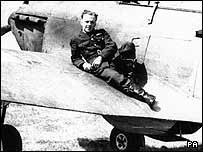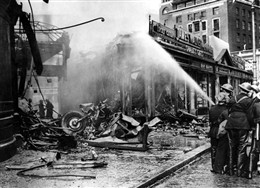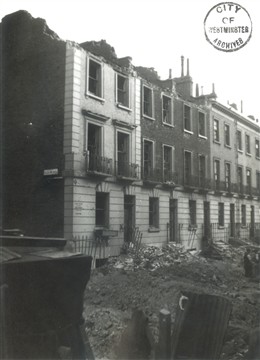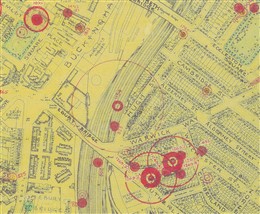Sgt Ray Holmes

Sgt Ray Holmes and Hurricane fighter
Copyright BBC Online

The crashed Dornier, Wilton Road, Victoria, 15 September 1940
Copyright Westminster City Archives

Hugh Street, where Ray Holmes landed
Copyright Westminster City Archives

Bomb Map: Sgt Holmes's Hurricane crashed close to Ebury Bridge and Buckingham Palace Road
Copyright Westminster City Archives
RAF Hurricane Pilot
By Ronan Thomas
On Sunday 15 September 1940 a force of some 250 Luftwaffe twin-engined Dornier Do17 and Heinkel HE 111 bombers, flying in two separate waves and escorted by ME109 fighters, was launched against London.
At 11am, the first wave - around 100 bombers approaching at altitudes of between 15,000 and 26,000 feet – flew in over Dungeness, Kent and headed up the Thames Estuary.
The German aircraft were tracked by radar, by RAF Fighter Command, Bentley Priory and by RAF No.11 (Fighter) Group Headquarters at RAF Uxbridge, north west London, under the command of Air Vice-Marshal Keith Park. That morning, Prime Minister Winston Churchill and his wife Clementine were observers at the Uxbridge underground Operations Room, watching events unfold from its curved glass gallery.
With intruder marker plots increasing on the map table below him, Park concluded that this force was the spearhead of a new, major effort by the Luftwaffe against the capital. He ordered its immediate interception by fighters from No.10, 11 and 12 Groups, between Dungeness and Canterbury.
Churchill reportedly turned to Park and asked where his reserves were. Park replied: "there are none". Fifteen Hawker Hurricane and eight Supermarine Spitfire squadrons (250 aircraft in all) were scrambled. As Churchill watched, the lights on the Ops Room readiness indicator board all glowed red. Every available fighter was engaged, from all seven of 11 Group’s sector airfields.
The Hurricanes and Spitfires began to intercept the German bomber stream at around 11.30am. By midday, the bomber formations had suffered damage and losses from the RAF fighter screen but had pushed through to arrive over central London.
504 Squadron (based at RAF Hendon) was vectored in to attack. Among 504’s Hurricane pilots that day was 26-year-old Sergeant Ray 'Arty' Holmes.
At noon, as the German aircraft flew on over the streets of the City of Westminster, Sgt Holmes – flying in Hurricane TM-B - identified three Dornier Do17s flying in a loose V-formation. One was damaged and apparently heading in a direct line toward Buckingham Palace.
The air action which then unfolded over Victoria was confused. There are several, conflicting, accounts.
According to Sgt Holmes' testimony, he fired on the first Dornier to enter his gunsight:
“I made my attack on this bomber and he spurted out a lot of oil, just a great stream over my aeroplane, blotting out my windscreen. Then, as the windscreen cleared, I suddenly found myself going straight into his tail. So I stuck my tail forward and went under him, practically grazing my head on his belly”.
Holmes then reported engaging a second bomber, from which an escaping crew member parachuted. Holmes described the airman’s parachute briefly tangling on his wingtip, before sliding off.
With his ammunition exhausted, Holmes stated he went after the third aircraft, in the process making contact with its rear fuselage and distinctive twin tail section, which sheared off.
The Dornier went out of control, lost its wing tips and crashed onto a tobacconist's shop in Wilton Road, opposite the New Victoria Cinema and close to the forecourt of Victoria Station. Its pilot had previously baled out and landed near Vauxhall Bridge in Kennington. Before he was arrested, the pilot was set upon by a crowd of locals. He died of his injuries in Queen Alexandra’s Military Hospital, Millbank the following day. The falling Dornier was filmed by a newsreel cameraman from rooftops below.
Holmes’ Hurricane was also severely damaged and he too was forced to bale out. Watching his fighter crash at Ebury Bridge, on Buckingham Palace Road, Pimlico, Sgt Holmes floated down by parachute. He landed on the slanting slate roof of a house in Hugh Street, adjacent to the main rail lines approaching Victoria Station, and slid down over the guttering into a garden below. His parachute caught on a drainpipe and Holmes ended up dangling a few feet above a dustbin. Two girls watching from the neighbouring garden recalled witnessing Holmes’ descent.
Unfastening his parachute harness (and identifying himself as an RAF pilot), he was given a cheery reception by local Westminster residents. After brandies in the Orange Brewery on Pimlico Road, Holmes was taken to the Chelsea Barracks mess and then back to his squadron in Hendon by taxi.
Overhead, the rest of the German aircraft dropped their bombs over central and south London but their effort was scattered rather than concentrated. As they flew back, they were attacked unremittingly by British fighters over Kent and the Thames Estuary. Many of those which escaped were damaged before they landed back at their bases in Belgium and France.
At 1.30pm, the second bomber wave - around 150 aircraft with a 400-strong ME109 fighter escort - approached London. A huge air battle developed over Kent as this force was engaged by 15 squadrons of 11 Group and the Duxford Wing including 303 (Polish) Squadron operating from RAF Northolt (one Polish pilot also reportedly rammed a German bomber on 15 September). Furious dogfights erupted. The interception did not prevent the German raiders from reaching their targets, but again their efforts were not concentrated and their bombs fell over a wide area: Islington, Kilburn, Hammersmith, Croydon and Mitcham.
15 September arguably proved the turning point of the Battle of Britain. 56 German aircraft were shot down that day versus 26 British fighters destroyed (13 pilots killed). In little over an hour and a half, 28 RAF Squadrons had seen action and had punched serious holes in the Luftwaffe attack. The Luftwaffe’s goal of daylight air superiority was dashed on 15 September. It had suffered its greatest casualties since 18 August (the so-called 'Hardest Day'). The RAF showed it could detect, intercept and destroy enemy bombers in unprecedented numbers. For his part, Churchill pointed to the critical significance of the day’s events. He later wrote: “We must take 15 September as the culminating date (of the Battle of Britain)”.
Sgt Ray Holmes continued to fly for the rest of the war, as a Hurricane pilot over France in 1941, as an instructor training Soviet aircrew in Murmansk, as a Spitfire photo-reconnaissance pilot and finally as a personal King’s Messenger pilot for Prime Minister Winston Churchill. He was promoted to Flight Lieutenant in 1941. After the war, he enjoyed a successful career as a journalist in Liverpool and wrote an account of his wartime experiences in 1989 (Sky Spy).
Holmes’ actions in the aerial dogfights of 15 September 1940 were revisited by the British media in 2004. Archaeologists dug up the remains of his buried Hurricane at Ebury Bridge, Buckingham Palace Road, recovering the aircraft’s Merlin engine. The excavation was covered live by television crews with Ray Holmes in attendance. The engine – weighing over a ton - was exhibited in Leicester Square by Westminster Archives for their ‘West End at War’ event the same year and was subsequently donated to the Imperial War Museum. Ray Holmes died in 2005 at the age of 90.
Newsreel footage of Sgt Holmes' interception over London on 15 September 1940 can be viewed below by copying the following link into your browser:
www.itnsource.com/shotlist//BHC_RTV/1940/09/19/BGU408020029/